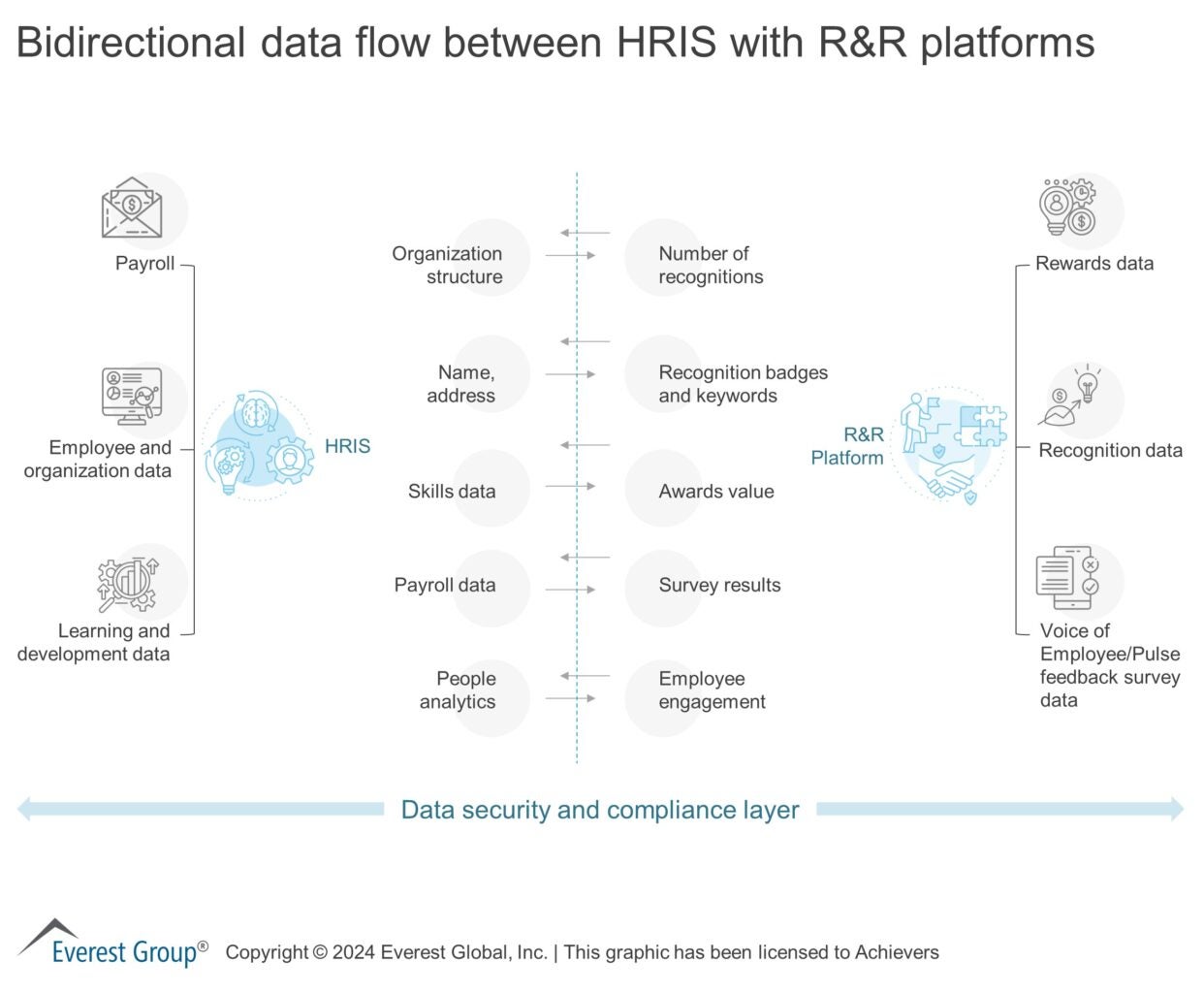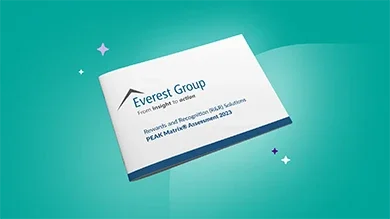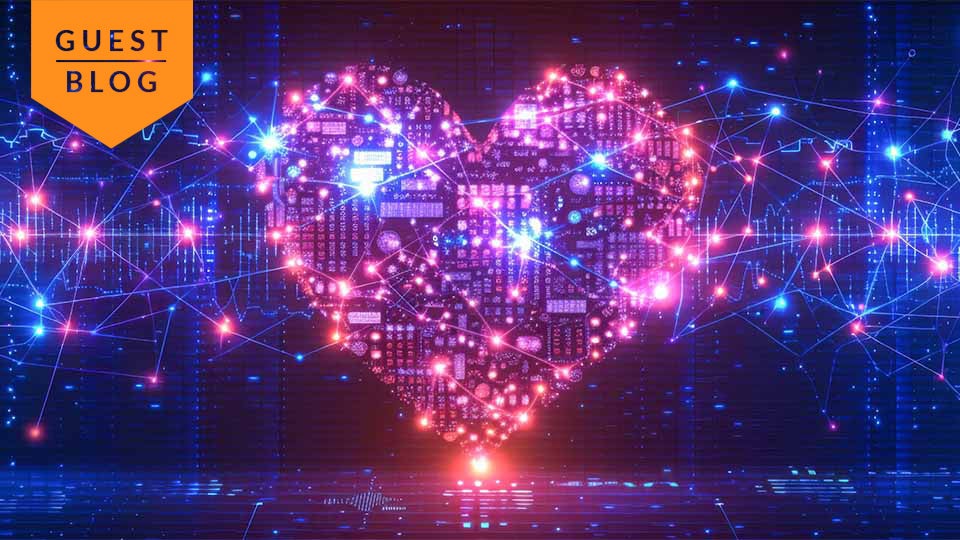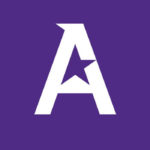Table of contents
Integrating Human Resource Information Systems (HRIS) with rewards and recognition platforms presents transformative potential for organizations, positively impacting culture and employee experience.
Research firm Everest Group guest bloggers Lokesh Goyal and Varun Madan offer benefits and insights for successful implementation
As organizations navigate the constant evolution of workplace dynamics, the significance of HR technology has become increasingly apparent. Human Resource Information Systems (HRIS) play a pivotal role, offering a centralized software solution that efficiently manages employee data.
When effectively utilized, HRIS is a gold mine of data that can significantly enhance HR functions and contribute to overall organizational success by streamlining processes, improving decision-making, and supporting strategic initiatives to maximize workforce potential. As businesses increasingly rely on technology to drive efficiency and innovation, integrating HRIS into the broader organizational framework and HR systems – including payroll, benefits, learning management, performance management systems, and employee experience solutions – is not only necessary but a strategic imperative.
How do rewards and recognition impact HRIS?
Rewards and Recognition (R&R) platforms foster a positive workplace culture. By seamlessly aligning R&R platforms with the overarching HRIS, organizations can amplify the impact of their talent management strategies. This integration ensures a cohesive, streamlined, data-driven approach, ultimately contributing to heightened employee engagement, satisfaction, and overall organizational success.
Exploring the potential benefits of HRIS integration with R&R platforms
Summarized benefits of integrating HRIS with R&R platforms:
- Improved data management with real-time automated data synchronization, comprehensive data tracking, and robust data security and compliance
- Increased productivity and efficiency for the admin team and frictionless user experience by pre-populating employee data from various sources
- Fosters a holistic employee performance view and a culture of continuous learning
- Comprehensive understanding of workforce dynamics through in-depth people analytics, coupled with convenient measurement of the impact of recognition initiatives
Organizations can propel recognition program success by strategically aligning HRIS with R&R platforms. The bidirectional data flow between HRIS and R&R platforms allows enterprises to tap into various HR metrics, including performance appraisals, skill-development records, and engagement levels. Moreover, it enables HRIS to incorporate recognition and rewards data, empowering organizations to deliver personalized and strategic recognition and fostering a sense of purpose and alignment within the workforce.
Three key benefits of aligning HRIS and R&R platforms
1. Improved data management
The data flow between R&R and HRIS is a structured mechanism for improving data management. It addresses key aspects such as real-time synchronization, comprehensive tracking, centralized storage, and enhanced data security and compliance. This integration contributes to a more robust and efficient data management framework within the organizational context.
Real-time automated data synchronization – Data flow between R&R and HRIS establishes a seamless real-time information exchange. This integration is pivotal in maintaining consistency by ensuring that R&R platforms remain synchronized with the most up-to-date employee information and organizational structure. This synchronization also significantly minimizes the risk of discrepancies when transferring recognition data related to performance, feedback, and awards to manage financial activities. Ultimately, this bidirectional integration enhances data accuracy, creating a reliable foundation for informed decision-making and efficient organizational processes.
Comprehensive data tracking – By enabling an R&R platform to feed data into a company’s HRIS, a comprehensive information sharing unfolds. The integration seamlessly incorporates recognition and rewards data with broad HR data such as leave information, performance appraisals, total rewards statements, skill development records, and engagement levels. This unified approach provides a nuanced understanding of employee contributions and performance, fostering more informed and strategic human resources management.
Data security and compliance – The integration ensures a secure transfer of sensitive employee information, facilitating seamless data updates. It strictly adheres to data protection regulations while placing a premium on safeguarding employee privacy. This approach mitigates potential data breaches or non-compliance risks, enhancing overall data security.
2. Elevating employee performance
This nexus effect, arising from integrating R&R and HRIS, significantly influences organizational culture and productivity.
Tailored learning and development initiatives – As R&R seamlessly integrates data into HRIS, employees gain a comprehensive overview of their achievements, recognitions, and skill development. This integration paves the way for personalized learning paths, motivating and incentivizing employees to invest in training by linking achievements to tangible rewards. The holistic performance view, combining R&R, appraisals, and skill records, ensures precise assessments, fostering a culture of continuous learning.
Productivity optimization – Implementing a seamlessly integrated tech setup enhances the team’s efficiency by eliminating administrative transactive processes such as service awards, birthdays, and other milestones. This reduces manual workload and mitigates the risk of human errors.
Enhanced employee experience – Integrating R&R with HRIS, characterized by bidirectional data flow, creates a seamless employee experience. Recognition becomes an integral part of the workflow, effortlessly tied to achievements and performance metrics. Automating processes reduces the administrative burden, making the overall experience smoother. This seamless experience contributes to increased employee satisfaction, engagement, and a positive organizational culture.

3. In-depth people analytics
Today’s macroeconomic and volatile environment has heightened organizations’ imperative to adopt in-depth people analytics as an essential strategic workforce management tool. Integrating HRIS and R&R platforms catalyzes advanced people analytics. With recognition data complementing insights from HRIS data, organizations can delve into comprehensive people insights, gaining a deeper understanding of workforce dynamics. The bidirectional data flow enables organizations to measure the impact of recognition initiatives on various performance indicators. It becomes possible to quantify improvements in metrics such as productivity, retention, employee performance, and overall job satisfaction. This data forms the basis for calculating the return on investment (ROI) of the organization’s investment in R&R programs.
Key enterprise considerations for HRIS integration with R&R
The integration is a strategic decision requiring enterprises to consider their options carefully. Choosing providers with certified partnerships with HRIS ensures seamless compatibility, optimal performance, and adherence to industry standards, enhancing the integration’s effectiveness and maximizing the organization’s benefits.
Sensitive core data protection – Integration involves the seamless data exchange between HRIS and R&R platforms. Since HRIS contains sensitive employee information, including personal and financial data, ensuring robust data protection measures is paramount. The integration should adhere to stringent security protocols, encryption standards, regional data protection laws, industry-specific regulations, internal policies, and data-protection regulations.
Challenges with open APIs – While open Application Programming Interfaces (APIs) facilitate the smooth flow of information between diverse software systems, challenges may arise. These potential issues include ensuring compatibility between different platforms, managing version control, and addressing potential security vulnerabilities. Conducting thorough testing and validation processes is imperative to identify and rectify any issues in the API integration and minimize the risk of data discrepancies or system disruptions.
The integration of HRIS with R&R presents transformative potential for organizations, significantly influencing organizational culture and employee experiences. This integration streamlines processes and also contributes to an elevated workplace environment. The streamlined processes resulting from this integration enhance operational efficiency and contribute to an overall positive employee experience. In essence, the integration of HRIS and R&R catalyzes organizational enhancement, aligning human resource practices with broader strategic goals.
Get the complete picture of 26 platform providers and how they are performing in Everest Group’s Rewards and Recognition (R&R) Solutions PEAK Matrix Assessment 2023/4.



